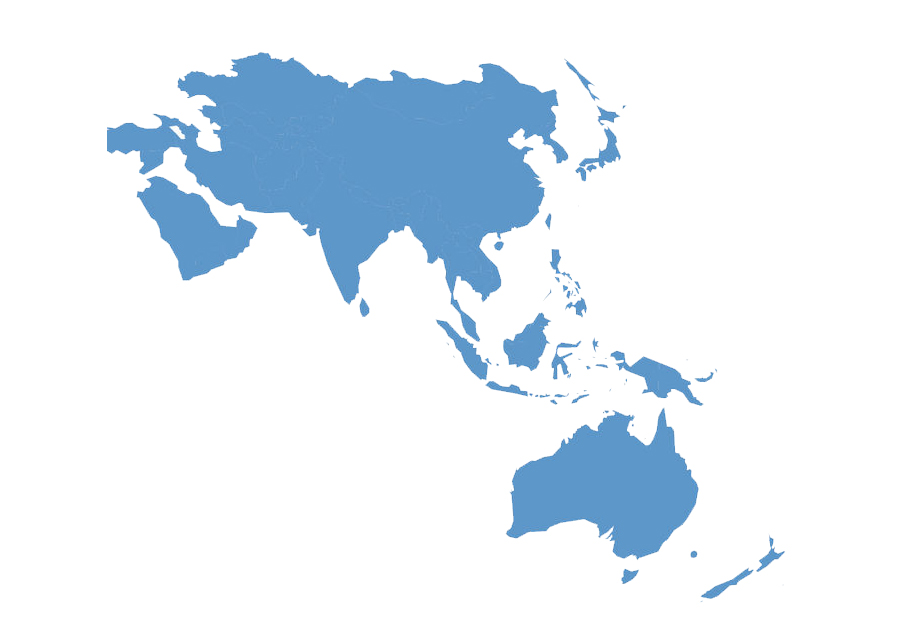President Yoon Suk-yeol used the ASEAN summit in Phnom Penh to outline South Korea’s Indo-Pacific strategy. Canada’s Foreign Minister Mélanie Joly has announced that Ottawa’s will be unveiled within a month. Apparently, the adoption of the Indo-Pacific concept and its operational application for a certain number of actors in Asia and the Pacific takes a long time. Our collaborator and columnist François Guilbert looked at the map of the Indian Ocean. And here are his observations…
China is not (any longer) satisfied with the folding seats that sub-regional organizations (e.g. Indian Ocean Commission (IOC), Association of Indian Ocean Rim States (IORA), Pacific Islands Forum (PIF)) have welcomed for several years. . While many countries are still contemplating their Indo-Pacific policies, the PRC is already implementing them on both sides of the ocean.
After visiting seven nations in Oceania (Solomon, Kiribati, Samoa, Fiji, Tonga, Vanuatu, Papua New Guinea) in May-June 2022 and meeting twice with his counterparts in less than a year, Foreign Minister Wang Yi slammed his interlocutors on the Pacific Islands proposes to do so not only to regularly continue their Ministerial Exchange launched on October 21, 2021, but also to support a Shared vision of development and a Five-year action plan for common development. Eagerness to see acceptance of documents as binding because they were drawn up without consultation meant that the communist leaders in Oceania suffered a crushing diplomatic setback. The texts put on the table by Beijing were publicly criticized and then officially rejected by most of the island states. Regardless, the Waijiaobu has resumed work and hopes its proposals will find takers quickly.
Failing to solidify the P pillar of an unnamed Indo-Pacific strategy, the People’s Republic of China has recently worked to institutionalize its relations with the Indian Ocean group of countries. This time, the maneuver was led not by the Ministry of Foreign Affairs but by China’s International Development Cooperation Agency (CIDCA). A less “political” setting than the Pacific island, but it’s true that China doesn’t just have friends in the Indian Ocean basin.
However, on November 21, 2022, it managed to set up the first China-Indian Ocean Region Development and Cooperation Forum (C-IORFDC). A first! No other country in the world had tried to rally around the heterogeneous group of nations whose common good is the Indian Ocean. This exercise is nonetheless an overhang as it complements the South Asia Forum established in 2018, the third edition of which was held on November 19 at the same venue.
19 countries and 3 international organizations participated in the C-IORFDC exercise. Here, unlike the Pacific island, not an oxygen-rich Taiwan, however, the chosen geographic architecture underscores the growing scope of the PRC’s ambitions. On January 9, 2022, during a visit to Sri Lanka, Minister Wang Yi was “satisfied” with proposing the establishment of an Indian Ocean Island Development Forum. Not only was his project accomplished in record time, showing Beijing’s urgency and determination to build its influence strategies, but he also brought together representatives from East Africa, the Middle East, Indian Oceania, the Indian subcontinent and Southeast Asia.
At the end of the meeting at ministerial level, there was no joint statement, but there was enough material for a joint press release. Nothing was less certain ahead of the meeting, as the concerns of countries on the west side of the Indo-Pacific are often unrelated. Also, the hitch was surprising.
Geographers will be surprised to see states of the Indian Ocean region in Afghanistan or Nepal. Their shoreline is not immediately obvious. The strategists will have noticed that almost all of India’s neighboring countries have reacted (Pakistan, Nepal, Burma, Bangladesh, Sri Lanka, Maldives). If we know how Timphu is most careful not to become involved in the Sino-Indian rivalries, New Delhi’s absence from the Kunming meeting represents a first-order symbol of rejection and is a reminder of how bitter the Sino-Indian Indian antagonism is played in the Indian Ocean(ra). The non-participation of three of the five ASEAN actors sitting in the intergovernmental bodies dealing with the Indian Ocean (Thailand, Malaysia, Singapore) also speaks volumes about the reluctance of certain states to consider contributing to platforms whose agenda is essentially guided by Beijing’s strategic interests. It is not Australia’s connection with C-IORFDC that radically changes the situation.
If Southeast Asia doesn’t take the place it could in China’s new strand of the Indian Ocean region, then so does the Arab-Persian Gulf region. Only Iran and the Sultanate of Oman attended this first C-IORFDC meeting. Vice versathe African facade was particularly well represented. It is true that Wang Yi’s project followed his stints in Eritrea, Kenya, the Comoros (January 4-7, 2022) and the Maldives (January 7-8). Of the six states that stretch from the Horn to the Cape, five responded (South Africa, Djibouti, Kenya, Mozambique, Tanzania). As for the Indian Ocean Commission, three of its five members (Madagascar, Mauritius, Seychelles) took part in the discussions, unlike France and the Comoros, who are very much courted by China.
This institutional geography shows how much Beijing’s bio-ocean strategy covers the broadest Indo-Pacific definitions, from the African coasts to the Polynesian triangle. And by holding the demonstration in Kunming and chaired by Yunnan’s governor and deputy secretary of the Communist Party of Yunnan, Wang Yubo, China underscored that its goal regarding the Indian Ocean is to open up its provinces from both the southwest and the south to open safe bypasses on the Straits of Malacca. In Beijing’s eyes, Yunnan is its center of influence towards South and Southeast Asia, although it is not so easy to reach the Indian Ocean from the birthplace of the mythical admiral Zheng He (1371 – 1433). A policy that requires close ties with power in Nay Pyi Taw to gain access to the Andaman Sea and Bay of Bengal. For this reason, and for all Beijing’s doubts about the Burmese state governing body, it had to invite a member of the junta government. The Minister for International Cooperation, Ko Ko Hlaing, took part in the hybrid orchestrated forum on November 21 via video conference.
An involvement that Nay Pyi Taw’s propaganda immediately reported to show how much the country is not isolated in the hands of the generals on the regional stage, as well as the recurring tensions with ASEAN and some of its member states. An operation made all the better by the fact that Burma is barred from the Indian Ocean’s main regional organization. In this case, Beijing and Nay Pyi Taw can be content to announce C-IORFDC 24 hours before April 22th IORA Ministerial Meeting in Dhaka. This calendar maneuver shows how much Beijing is challenging existing regional multilateral bodies by pinning them with web-like platforms in China alone. However, the countries of the region are certainly not ready to quickly abandon their regional organizations that have been built up over time, as these serve to define the common approaches of their members while at the same time maintaining a certain distance from the collective decision-making center outside the region. Regional powers like China, Russia, the United States and even Japan and the European Union. The IORA meeting in Bangladesh gathered 23 members and 10 interlocutors, 1.5 times more participants than the new Chinese forum.
While Beijing’s initiatives accentuate a proliferation of foreign regional bodies to the detriment of the consolidation of indigenously developed and run platforms, it is essentially masking its challenge to the existing multilateral order by trying to align itself as closely as possible with the to hold political recitations by the islanders. The theme of the Kunming meeting was “ development for everyone » and the implementation conditions of the island political grammar of supporting the “blue economy”, protecting the seas or supporting cooperation mechanisms to prevent and contain maritime disasters. But in order not to lose the lead in the recitative of cooperation and encourage tomorrow’s initiatives, China has proposed setting up a think tank dedicated to the blue economy of the Indian Ocean on its territory. In order to convince the possible refractory, the CIDCA assured the state partners financial support from the province of Yunnan. After China has established its arena of exchanges with the Indian Ocean States, outlined lines of cooperation, offered intellectual, administrative and financial instruments to support the projects, it has yet to bring this strategy to life over time in order to complete the C-IORFDC with the to convince other Chinese sub-groups (e.g. South Asia Forum, Maritime Silk Road etc.) and to convince that the fence installed on November 21 will become “THE” main decision-making center for future regional cooperation with the so-called Indian Ocean States can .
Francois Guilbert

Twitter enthusiast. Organizer. Explorer. Reader. Zombie aficionado. Tv specialist. Thinker. Incurable internet maven.





;Composite=(type=URL,url=https://images.radio-canada.ca/v1/assets/elements/16x9/outdated-content-2017.png),gravity=SouthEast,placement=Over,location=(0,0),scale=1)
;Composite=(type=URL,url=https://images.radio-canada.ca/v1/assets/elements/16x9/outdated-content-2020.png),gravity=SouthEast,placement=Over,location=(0,0),scale=1)